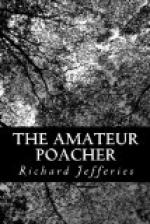The ploughed field that comes down almost to the brook—a mere strip of meadow between—is green too with rising wheat, high enough now to hide the partridges. Before it got so tall it was pleasant to watch the pair that frequent it; they were so confident that they did not even trouble to cower. At any other time of year they would have run, or flown; but then, though scarcely forty yards away and perfectly visible, they simply ceased feeding but showed no further alarm.
Upon the plough birds in general should look as their best friend, for it provides them with the staff of life as much as it does man. The earth turned up under the share yields them grubs and insects and worms: the seed is sown and the clods harrowed, and they take a second toll; the weeds are hoed or pulled up, and at their roots there are more insects; from the stalk and ears and the bloom of the rising corn they seize caterpillars; when it is ripe they enjoy the grain; when it is cut and carried there are ears in the stubble, and they can then feast on the seeds of the innumerable plants that flowered among it; finally comes the plough again. It is as if the men and horses worked for the birds.
The horse-chestnut trees in the narrow copse bloom; the bees are humming everywhere and summer is at hand. Presently the brown cockchafers will come almost like an army of locusts, as suddenly appearing without a sign. They seem to be particularly numerous where there is much maple in the hedges.
Resting now on the sward by the stream—contracted in seeming by the weeds and flags and fresh sedges—there comes the distant murmur of voices and the musical laugh of girls. The ear tries to distinguish the words and gather the meaning; but the syllables are intertangled—it is like listening to a low sweet song in a language all unknown. This is the water falling gently over the mossy hatch and splashing faintly on the stones beneath; the blue dragon-flies dart over the smooth surface or alight on a broad leaf—these blue dragon-flies when thus resting curl the tail upwards.
Farther up above the mere there is a spot where the pool itself ends, or rather imperceptibly disappears among a vast mass of aquatic weeds. To these on the soft oozy mud succeed acres of sedge and rush and great turfs of greyish grass. Low willows are scattered about, and alder at the edge and where the ground is firmer. This is the home of the dragon-flies, of the coots, whose white bald foreheads distinguish them at a distance, and of the moorhens.
A narrow lane crosses it on a low bank or causeway but just raised above the level of the floods. It is bordered on either side by thick hawthorn hedges, and these again are further rendered more impassable by the rankest growth of hemlocks, ‘gicks,’ nettles, hedge-parsley, and similar coarse plants. In these the nettle-creeper (white-throat) hides her nest, and they have so encroached that the footpath is almost threatened. This lane leads from the Upper Woods across the marshy level to the cornfields, being a branch from that down which Luke the contractor carried his rabbits.




